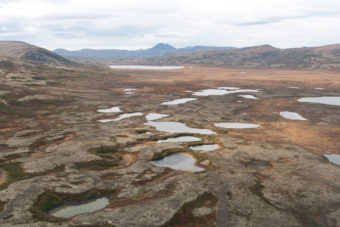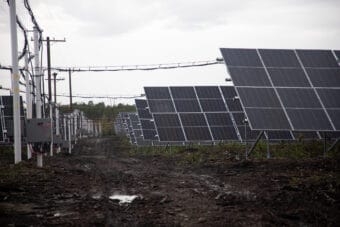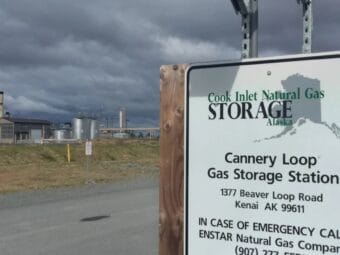
Perched high above Kachemak Bay, Scott Waterman’s house in Homer is a museum of energy-efficient technology. A heat pump hangs on the side of his garage. Out front, a hulking row of blue solar panels angle toward the high April sun.
Waterman, a retired energy programs manager, has been building his setup for more than a decade. But, he said, today there are more people considering upgrades of their own.
“There are lots of people, now, thinking about how they can use solar to not necessarily just lower their costs of utilities, but to avoid the volatility,” he said.
That volatility is going to be inevitable as heating and electric utilities from Homer to Fairbanks — an area known as Alaska’s Railbelt — have to reconsider where they’re getting their power.
For a long time, they’ve sourced most of it from Cook Inlet natural gas. But now, for the second time in just over a decade, utilities and lawmakers in Southcentral Alaska are talking about importing liquified natural gas amid looming gas shortages in Cook Inlet.
Oil and gas producer Hilcorp — which has a sort of monopoly in Cook Inlet and provides some utilities with as much as 85% of their gas supply — recently warned that it won’t commit to signing new gas contracts, and few other companies are interested in looking for more gas in the inlet. That means Alaskans will likely have to pay more — maybe even a lot more — in a state that already has some of the highest energy costs in the country.
“That’s worrisome,” said Waterman, who worked for years with low-income renters at the Alaska Housing Finance Corporation. “If that’s a trend that continues, many, many people are going to have hard times making the choice as to whether to pay their power bill or buy groceries for their children.”
Years of warning
The impending gas shortages have loomed for decades.
Newspaper headlines in the 1990s warned that there wasn’t enough gas production in Cook Inlet to keep business going forever, and the state has long forecasted that demand for gas in Southcentral would outpace supply without more production. The most recent numbers estimate that could happen as soon as 2027.
Still, over the years Alaska has largely remained dependent on natural gas, building storage facilities to hold more and subsidizing production through big legislative packages.
“And we just have put all our eggs in that basket, ever since,” said McKibben Jackinsky, a retired oil and gas journalist in Ninilchik, on the southern Kenai Peninsula.

She said Alaska has always known natural gas was a bridge between other hydrocarbons and greener sources of energy, and that Cook Inlet wasn’t going to have gas to last a lifetime. Now, she said Hilcorp wants to drill on her property as it looks for more gas to meet its contracts.
“It’s the one leg under our stool and when it moves, we just collapse,” she said. “ And we can’t see beyond that, you know? We can’t see beyond developing something else that will sustain us, truly, without having to have this fear put in us every few years about running out.”
Alaskans aren’t going to freeze, or face blackouts.
What’s at stake here is cost. In the short term, utilities are considering new Cook Inlet gas supply contracts and imports of liquified natural gas, or LNG, which will be more expensive for Railbelt customers.
To get that LNG, utilities could go out to the spot market — where gas can be purchased for immediate delivery, but where it can be more than twice as expensive as what they’re paying now. The price is much more volatile, too. The other option is utilities will have to lock into longer-term contracts, if they can get them. How much those contracts would cost is unknown, since Alaska has never before had to import gas.
So — with decades of warning, how did Alaska get here?
“I just think it’s a human nature thing,” said Peter Micciche, mayor of the Kenai Peninsula Borough and former manager of the liquified natural gas plant in Kenai.
“We get very comfortable very quickly when things seem solved,” he said. “And we have a very difficult time having a long-term comprehensive plan and when we mobilize, and when we don’t.”
He wonders what higher and more volatile energy costs could mean for his constituents.
“And that’s going to be a problem for us,” he said. “I can’t imagine the Railbelt not having adequate supplies of natural gas.”
Deja vu all over again
There’s a framed copy of a 1958 Anchorage newspaper hanging on the wall of Micciche’s Soldotna office. In big, block type, it reads, “WE’RE IN” — marking the moment Alaska became the 49th state.
That was thanks, in no small part, to oil discoveries on the Kenai Peninsula. In their search for oil, companies stumbled across large reserves of natural gas, which they shipped out to Japan from a liquified natural gas plant in Kenai. Producers also sold a lot of gas to a fertilizer plant next door.
Micciche, now mayor of the Kenai Peninsula Borough, remembers coming to work for Tesoro as a summer intern in Kenai in 1982. Later, under ConocoPhillips, he managed the export facility – which, for decades, was the country’s only exporter of LNG.
“In 22 months, from conception to operation, they designed and built the LNG terminal, the platform, the pipelines, the receiving terminal in Tokyo harbor, the regasification facility in Tokyo, and the ships that would go back and forth and cross halfway through for 40 years,” he said.
There was plenty of gas to go around — too much. Big companies like Chevron, ConocoPhillips, Marathon and Unocal produced gas from large fields and sold the excess to Alaska utilities at very low prices. That kept costs low for Alaska consumers — well below the national average.
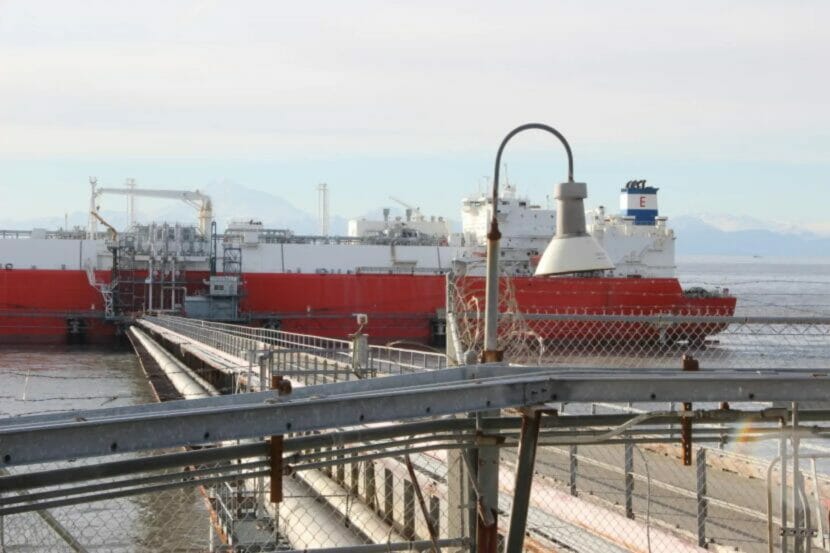
Still, it was known that the market wasn’t going to last forever. The easiest-to-reach gas ran out, and without money flowing in from overseas, companies weren’t interested in drilling expensive new wells when they had better prospects elsewhere. Agrium, which used cheap gas to make fertilizer, closed its Kenai plant in 2007 when the price of gas went up.
The export facility saw a steep drop-off in shipments in 2005 and largely stopped exporting a few years later in 2013, with just a few small cargoes going out after that. ConocoPhillips mothballed the facility in 2017, citing competition.
That left just one gas market intact — local utilities. And that market was too small to keep the big companies invested. They left, and Southcentral Alaska was left wondering if it had enough gas to keep the lights and the heat on.
“It’s definitely history repeating itself,” saidAnchorage Democrat Sen. Bill Wielechowski, who co-chaired the Senate Resources Committee at that time.
Without interest in new production, Southcentral Alaska was, like today, facing the possibility of not having enough local gas to meet its energy needs.
“They’re saying we’re running out of gas in Cook Inlet. It’s the same exact scenario,” Wielechowski said. “I remember in Anchorage, going back a ways, people talking about brownouts.”
Then, in 2010, the Alaska Legislature passed the Cook Inlet Recovery Act. The act provided incentives for oil and gas companies to make claims in the inlet and expanded existing tax credits.The Alaska Public Interest Research Group, a consumer advocacy nonprofit, estimates that the state granted $1.64 billion in tax credits for oil and gas production between 2006 and 2016, when the Legislature retired those credits.
Jackinsky, the retired oil and gas journalist, said those incentives were never about putting money in the state’s coffers. Officials were clear that they were meant to literally keep the lights on.
“It was for us to continue our nice, easy lifestyle, dependent on natural gas,” she said.
In some ways, the act was a short-term success. It helped usher in a new oil and gas production company and Alaska avoided having to import gas, as lawmakers had feared.
But Wielechowski, who still serves on Senate Resources today, said it didn’t solve the root of the problem.
“We’ve got these massive incentives that we’ve provided over the years,” he said. “And it just hasn’t worked. And so I think it’s time for us to look at what are some different policy options we can look at? Because obviously what we’re doing is not working.”
From the other side of the aisle, Micciche also took issue with the bill because he said it didn’t provide any production requirements for companies.
“We have to get the Legislature to look more in advance at solutions so we don’t make sloppy decisions going forward,” he said. “You have to think about the behavior you want to see before you create an incentive.”
There was another product of the recovery act: the Cook Inlet Natural Gas Storage Alaska facility.
Lindsey Hobson is a spokesperson for Enstar, the gas utility that runs the facility off Beaver Loop in Kenai. Enstar supplies gas to about half of Alaska’s population and gets all of its gas from Cook Inlet.
Standing among CINGSA machines that compress gas before it heads into five underground wells, across the street, she said Enstar and other electric utilities dip into those reserves when they need gas most, on the coldest days. The facility can hold 11 billion cubic feet of gas — about a third of the amount Enstar customers use each year.
“We can take greater volumes in the summer and store those volumes and call on them in the winter when we require more gas,” she said.
Hobson said the utilities are considering more storage as another partial solution, this time. But storage alone won’t fix Southcentral’s problems. She said a crucial factor back in the 2010s was the entry of a new company into Cook Inlet.
“And that’s an important piece, and something that we are looking for in terms of, what will that next step be? What will that major investment be?” Hobson said.
A Goldilocks company
When supermajor oil and gas companies lost interest in Cook Inlet and left in the early 2000s and 2010s, a new company entered — Hilcorp, a Houston, Texas-based company whose strategy of rehabilitating old oil and gas fields made them a good fit for the aging basin.
“Hilcorp was a Goldilocks company,” said Antony Scott, who was a commercial analyst with the state’s Division of Oil and Gas when Hilcorp entered the inlet.
He said Hilcorp was big enough that it had the capital to invest in the inlet and expertise to redevelop old fields.
“But they were also small enough that the prizes available were a pretty good fit for their capacities and their objectives as a company,” he said.
Hilcorp had a strategy that worked for the aging oil and gas basin — squeeze the last bits of production out of existing rigs and platforms and get them going again. The company’s then-CEO described it as a “quick hit, remedial program,” according to a 2012 story from the Anchorage Daily News.
Scott said that model was more economic for Hilcorp than building big new projects, which could cost millions of dollars and take years to permit.
As a result, Hilcorp outlasted other companies that tried to come in and gained a sort-of monopoly on Cook Inlet natural gas. The company bought up Chevron’s assets, and then Marathon’s. It hired an all-Alaskan staff and signed long-term contracts with utilities.

But Scott said that strategy won’t keep the basin going forever. Without a willingness to build new platforms to access harder-to-get Cook Inlet gas, there has always been an expiration date, especially as future demand for gas in Southcentral remains an unknown.
“What we need now are new resources,” Scott said. “And the problem with bringing on brand-new resources is that the geologic risk is much bigger. You really don’t know what you’re going to find.”
Last spring, Hilcorp told utilities it wouldn’t guarantee future contracts and that it would like utilities to be less reliant on the company to meet their energy needs.
They’ve said little, publicly, about their reasoning. Company spokesperson Luke Miller, in an emailed statement, said the company is working with utilities to develop a way forward.
“In recent years, as Hilcorp has been asked to shoulder more of the burden, we felt it was prudent and responsible to communicate with Railbelt utilities our long-term view of the Cook Inlet basin, particularly as other producers have exited and non-Hilcorp investment levels have fallen significantly,” Miller statement said, adding that the company plans on investing nearly a billion dollars or more on new projects in Cook Inlet over the next five years, including drilling new gas wells.
Lackluster industry interest
Economists and industry experts, like Scott, say business in the inlet isn’t as profitable for Hilcorp as it used to be. New development is getting harder and more expensive, while the market remains relatively small.
“We just have a problem where the risks and the size of the market and the incentives don’t seem to be hanging together,” Scott said.
At a State Senate hearing in January, Department of Natural Resources Commissioner John Boyle warned of low interest from new companies in the basin. Today, there are a myriad of smaller, local oil and gas companies in Cook Inlet, like HEX and Blue Crest. But they’re not producing enough to sign big contracts.
“We do see an environment where there’s a need for policy discussion around if the path that we’re on is sustainable for providing energy to Southcentral into the future,” Boyle told lawmakers.
Jackinsky, the retired journalist, said those discussions are overdue.
“There was a need for policy discussion, how many years ago?” she said.
She’s frustrated that the Railbelt is still so dependent on natural gas, even though it’s been clear for so long that gas was a finite resource and that supply shortages loomed.
And now, it’s personal. With demand for gas high and years left on some of its contracts, Hilcorp is looking for gas in her backyard. The company is drilling new wells from onshore pads on the southern Kenai Peninsula, where it’s much cheaper and easier to explore. The gas from those wells won’t be a panacea to the shortages, and don’t replace the level of production that could come from new fields, but it could backfill some declines in Cook Inlet production.
Jackinsky said Hilcorp has asked for the subsurface rights to her property — a parcel in Ninilchik passed down through generations from her homesteading ancestors.
She and her daughters have told Hilcorp no, repeatedly. Hilcorp won’t comment on conversations it’s had with property owners on the southern peninsula.
But some of her neighbors have already signed with the company.Nearby, the company is burning off gas to get rid of the excess as it tests new wells — a noisy process known as flaring.
“That comfortable lifestyle that the state talked about, and has subsidized — it may be continuing it for some people. But it’s ruined that lifestyle for me and my neighbors,” she said.
Searching for the big home run
The gas-dependent Railbelt utilities are patching together other ways to get natural gas to power Alaskans’ homes in the next few years. They’re meeting monthly, along with two state groups, to brainstorm solutions to their Alaska supply woes.
Hobson, Enstar’s spokesperson, said the group plans on coming out with a report with some possible solutions in June.
“I think that all options are on the table, at this point,” she said earlier this year.
So — what are the options?
In the short term, utilities are looking for other ways to get natural gas.
Some with near-expiring contracts are signing agreements to buy supply from other utilities that have years still before theirs run out.
Homer Electric Association, for example, gets 85% of its power from Cook Inlet natural gas through a contract with Hilcorp that expires next year — the soonest expiration date on the Railbelt. Last month, the utility signed a procurement agreement with Enstar to get some of its gas; Enstar’s contract with Hilcorp doesn’t expire for another decade. As a gas utility, Enstar has fewer options to diversify its power generation away from gas on a short time frame than electric utilities do.
The terms of the agreement between Enstar and HEA have not yet been approved by the Regulatory Commission of Alaska and therefore aren’t public yet, according to HEA, so it’s hard to say how that will impact pricefor HEAcustomers. Fairbanks’s Golden Valley Electric Association signed a smaller contract with Enstar this year that included gas at a small markup over what Enstar currently gets for its gas.
And now, utilities are talking about considering importing LNG from out of state. Imported LNG would be more expensive than the local gas utilities get and could raise residential rates by as much as 30%, in some cases.
Earlier this year, Chugach Electric Association CEO Arthur Miller told state legislators that importing is not a step utilities want to take.
“We think that would be a very unfortunate situation,” Miller said. “A state as rich as Alaska is with natural gas to have to import LNG. However, we recognize we need gas, and we want to have a competitive price for that gas. And if that’s what it will take to get gas, then we will pursue that.”
Homer Electric Association said it’s working on cost studies and analysis for getting LNG from multiple suppliers. Enstar also has a study in the works on gas supply options from out of state.
Pricing would depend on whether utilities get that LNG from the spot market or through long-term contracts. Prices for spot market gas are much more volatile. But renewables advocates worry long-term contracts would lock utilities into expensive deals and that would take away any incentive to diversify into other energy sources.
Any plan to import would also require building up infrastructure to bring in gas, and factoring in those costs. Marathon, which now owns the former export facility, is considering turning that plant into an import facility.
Champions of the long-fought Alaska LNG project say it’s time to start talking about that plan again. The project would send natural gas down from the North Slope to Nikiski for export and use in the state.
Cost has long been an obstacle to the Alaska LNG project, and previous employees of the project say it’s never going to happen. There’s also talk of a smaller project, known as the bullet line, or “ASAP line” — a 36-inch-diameter pipeline that would bring gas down from the North Slope for use domestically. But without buyers overseas helping to finance the project, it seems financially unviable.
Micciche, the Kenai Peninsula Borough mayor, said hopes enthusiasm from potential buyers abroad could finally push the Alaska LNG project across the finish line.
“I think it would buy us the time for a responsible transition, where renewables will fit into the global portfolio,” he said.
Raising the standard
Some renewables advocates say the time for that transition is now.
Solar and wind projects are becoming cost competitive with natural gas and some private power producers have approached utilities and municipalities with plans to place large-scale projects on their grids.
Alaskans across the political spectrum are now acknowledging that renewable energy will have to provide a larger share of Alaska’s power in the future. Republican Gov. Mike Dunleavy’s administration is working on a bill to make geothermal projects more affordable. And Hilcorp itself is looking into turning some of its old Cook Inlet oil platforms into tidal sites. That’s on top of multiple other permitted tidal projects that would turn Cook Inlet’s massive tides — some of the biggest in the world — into power, but would take years to come to fruition.
Today, the Bradley Lake Hydroelectric Project, across Kachemak Bay, provides the cheapest power to the Railbelt. Utilities across the Railbelt have a stake in, and get power from, the project.
But that’s one of the only large-scale renewable energy projects in the region. Chris Rose with the Renewable Energy Alaska Project said utilities aren’t doing enough, and that it’s time to stop waiting around for the big homerun.
“I think there’s always this notion that something is going to come in and change things,’ he said. “But the fact is is that we haven’t got a gas pipeline yet, even though we’ve been talking about it for 40 years, and we’ve also never gotten a hometown discount on oil and gas in Alaska, so even though we produce oil and gas, we have some of the highest energy costs in the country.”
He has been trying to get legislation passed that would set a renewable portfolio standard, which would require electric utilities to get a certain percentage of their energy from renewables by a certain date.
As it stands, those utilities have goals to incorporate renewables into their portfolio. Homer Electric Association, for example, has a goal of reaching 50% renewable energy by 2025 — a goal set by then-Gov. Sarah Palin’s administration. The utility says it’s in its best interest to not be so majorly dependent on one producer for power.
But with two years away from that non-binding deadline, HEA gets just 14% of its power from the Bradley Lake hydro project. It estimates it could meet about 25% of its demand with renewables by 2027, the year gas demand is expected to outpace supply, through another hydro project, a solar project and a landfill gas project, according to a January filing with the Regulatory Commission of Alaska.
Rose said aspirational goals are not good enough. His legislation would fine utilities about $20 per megawatt hour if they don’t meet certain standards — 25% renewable by 2027 and 80% by 2040.
He said those standards would help create competition among private energy companies — something the Railbelt doesn’t have much of now — that would generate power in state to sell back to the utilities.
And he said unlike LNG on the world market, energy from renewable projects in Alaska could be more stably priced.
He said it’s not just about Alaskans’ gas and electric bills, although that’s important. It matters a lot for the broader state economy.
“We already have very high energy prices in the Railbelt,” Rose said. “And so we can’t really afford to be increasing our energy costs. That’s going to impact businesses, that’s going to impact people’s decisions to invest here, and to live here.”
Rose’s standard, widely opposed by utilities, didn’t pass before the regular session ended. For most of the session, lawmakers were focused on big-ticket items like the PFD and school funding, rather than energy.
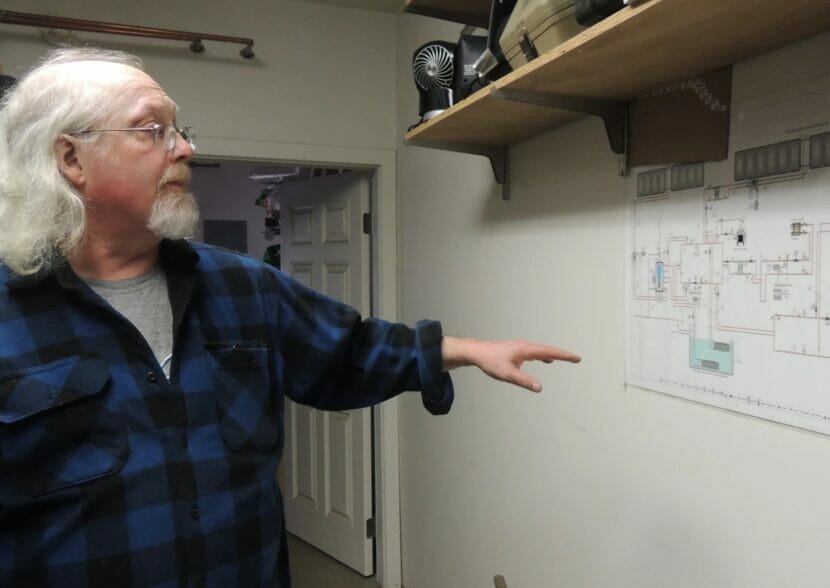
In the absence of action from lawmakers and utilities, some Alaskans are taking matters into their own hands.
Waterman, the Homer resident, said the solar panels, heat pumps and other energy efficient upgrades on his house help reduce the pressure he’s putting on the system.
“If we could get 25% of the homes on the Kenai with 5 to 10 kilowatts of of solar on them, that would make a significant dent in the gas that Homer Electric has to purchase — and keep our costs from rising quite as rapidly,” he said.
As an energy efficiency enthusiast, Waterman is maybe more attuned to his own rates than most.
But at the end of summer, when they switch on their lights and turn up their thermostats again, all Alaskans should be thinking more about how their lives could be impacted when the costs of doing so are a lot more expensive.

